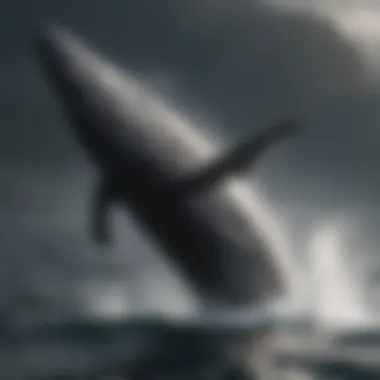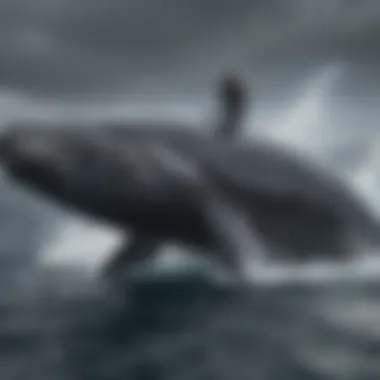Unveiling the Remarkable Evolution of Whale Populations Throughout History


Animal Species Profile
- The journey through the evolution of whale populations over time begins with an intricate look into the captivating world of these immense creatures. Known for their vast size and distinct aquatic lifestyle, whales have long been a subject of fascination and study.
- Physical characteristics and appearance: Whales are known for their sleek, streamlined bodies, which propel them gracefully through the depths of the ocean. Their most striking feature is undoubtedly their tails, or flukes, which power their movements through the water with impressive force. From the majestic humpback to the mighty blue whale, each species showcases unique physical attributes that set them apart in the marine world.
- Natural habitat and distribution: Whales are denizens of the deep oceans, where they navigate vast expanses of water in search of food and companionship. Their habitats range from polar regions to tropical seas, reflecting their diverse adaptability to different environmental conditions. The distribution of whale populations across the globe offers insight into the dynamic and interconnected nature of marine ecosystems.
- Behavior and social interactions: Whales exhibit complex social behaviors that encompass communication, migration, and communal activities. These marine mammals are known for their vocalizations, which serve as a means of bonding and navigation in the vast ocean expanse. From breaching and spyhopping to cooperative hunting strategies, whales showcase a remarkable array of behaviors that highlight their intelligence and social cohesion.
Prelude to Whale Population Dynamics
Whale population dynamics hold a crucial role in understanding the intricate balance of marine ecosystems. This section serves as a doorway to the in-depth exploration of how whale populations have evolved over time and the crucial factors influencing their numbers. By delving into historical perspectives, factors impacting whale populations, and the significance of whale conservation, a holistic view of the complexities surrounding these majestic creatures comes to light. Through a meticulous analysis of their journey from ancient times to modern conservation efforts, readers gain profound insights into the enduring relationship between whales and their environment.
Historical Perspectives
Whaling Practices in Ancient Civilizations
Exploring the practices of whale hunting in ancient civilizations unveils a prominent chapter in the story of human-wildlife interaction. This subheading illuminates the methods, motivations, and consequences of whaling practices in societies long gone. The discussion surrounding this topic sheds light on the pivotal role of whales in the lives of our ancestors and their exploitation for various purposes. Understanding the nuances of whaling practices in ancient times provides a unique lens through which to view the evolution of human perspectives towards whales.
Impact of Industrialization on Whaling
The advent of industrialization marked a significant turning point in the history of whaling. This subsection delves into how the rapid technological advancements during this era revolutionized the efficiency and scale of whale hunting. By exploring the implications of industrialization on whaling practices, readers gain a deeper appreciation for how human activities have shaped the destiny of whale populations. Analyzing the impacts of industrialization on whales offers valuable insights into the intersection of technology, commerce, and environmental conservation.
Role of Whales in Indigenous Cultures
Whales have held profound cultural significance for indigenous communities across the globe. This segment explores the diverse ways in which whales have been revered, mythologized, and integrated into the cultural fabric of various indigenous groups. By examining the spiritual, ceremonial, and practical roles that whales have played in indigenous cultures, a rich tapestry of traditions and beliefs emerges. Appreciating the intrinsic connection between whales and indigenous peoples deepens our understanding of the human-wildlife bond and the importance of cultural heritage in conservation efforts.
Factors Influencing Whale Populations


Climate Change Effects
Exposure to the effects of climate change poses a considerable threat to whale populations worldwide. This section delves into the specific ways in which rising temperatures, ocean acidification, and changing ocean currents impact the habitats and behaviors of whales. By scrutinizing the intricate relationship between whales and their changing environment, we unveil a sobering narrative of adaptation and survival in the face of global environmental challenges. Understanding the multifaceted effects of climate change on whales is paramount in crafting effective conservation strategies for their long-term well-being.
Human Activities like Pollution and Shipping
The rampant increase in human activities such as pollution and shipping poses a direct risk to whale populations inhabiting coastal waters and migratory routes. This portion explores the repercussions of pollution, noise pollution, oil spills, and habitat degradation on the health and safety of whales. By dissecting the detrimental effects of human presence in marine environments, readers gain a nuanced perspective on the urgent need for sustainable practices and policies to mitigate anthropogenic threats to whale populations.
Impact of Overfishing on Prey Species
The delicate balance of marine ecosystems is intricately linked to the availability of prey species for whales. Overfishing, driven by commercial interests and unregulated practices, has significantly disrupted the food chain essential for the survival of many whale species. This segment underscores the cascading effects of depleted fish stocks on whale populations, emphasizing the intricate web of interdependence within oceanic ecosystems. By examining the consequences of overfishing on prey species, we unveil a critical aspect of the conservation narrative that warrants immediate attention and action.
Significance of Whale Conservation
Ecosystem Balance
Whales play a pivotal role in maintaining the delicate balance of oceanic ecosystems. This segment delves into the far-reaching impacts of whales as keystone species, influencing marine biodiversity, nutrient cycling, and carbon sequestration. By elucidating the ecological functions of whales, readers grasp the profound consequences of their presence or absence on marine habitats. Understanding the significance of whales in ecosystem balance underscores the urgency of conservation efforts aimed at preserving these charismatic megafauna for the well-being of our planet.
Cultural Importance
Across cultures and civilizations, whales have captivated the human imagination and heart, becoming emblematic of wisdom, strength, and harmony with nature. This section explores the deep-rooted cultural importance of whales in art, folklore, and spiritual beliefs, highlighting their symbolic significance in shaping human identity and relationships with the natural world. By unraveling the cultural tapestry woven around whales, readers gain a deeper appreciation for the enduring influence of these marine giants on human creativity, spirituality, and cultural heritage.
Economic Value of Whale Watching


The burgeoning industry of whale watching stands at the intersection of conservation, tourism, and economic development. This subsection investigates the economic benefits and challenges associated with whale-watching activities worldwide. By examining the revenue streams, employment opportunities, and sustainability practices tied to whale-watching enterprises, readers uncover the intricate dynamics of balancing economic interests with conservation imperatives. Evaluating the economic value of whale watching offers a pragmatic perspective on harnessing ecotourism as a tool for conservation and community engagement, fostering a harmonious relationship between human interests and wildlife preservation.
Case Studies and Observations
When delving into the study of whale populations, case studies and observations play a pivotal role in unraveling the intricate dynamics at play. These in-depth examinations provide crucial insights into the behavior, population trends, and ecological impact of diverse whale species. By closely observing and documenting the challenges and successes faced by different whale populations, researchers can identify patterns, formulate conservation strategies, and contribute to the sustainability of marine ecosystems. Case studies and observations offer a glimpse into the real-world implications of human activities, environmental changes, and conservation efforts on whale populations.
Population Dynamics of Blue Whales
Blue whales, the largest mammals on Earth, present a fascinating case study in understanding the impact of conservation measures on vulnerable species. The recovery after the ban on commercial whaling stands out as a noteworthy milestone in the conservation of blue whales. This ban has played a crucial role in stabilizing and even increasing blue whale populations in some regions, indicating the potential for species recovery when human-induced threats are mitigated. The effects of climate change on migration patterns further highlight the adaptive challenges faced by blue whales. Climate-induced shifts in prey distribution and ocean temperatures can significantly influence the migration routes and feeding behaviors of these majestic creatures, underscoring the interconnected nature of conservation efforts and environmental changes.
Recovery After Ban on Commercial Whaling
The recovery of blue whales following the ban on commercial whaling showcases a positive trajectory in population rehabilitation. By halting the indiscriminate hunting of blue whales for their valuable resources, conservation initiatives have allowed these giants of the ocean to slowly regain their numbers. This recovery process signifies a collective commitment to preserving biodiversity and acknowledging the critical role of blue whales in marine ecosystems. Despite ongoing threats such as climate change and habitat degradation, the ban on commercial whaling remains a crucial pillar in safeguarding the future of blue whales.
Effects of Climate Change on Migration Patterns
Climate change exerts a significant influence on the migration patterns of blue whales, posing challenges to their traditional routes and foraging grounds. As ocean temperatures and currents undergo shifts, blue whales must adapt their migration behaviors to navigate changing environmental conditions. The effects of these alterations extend beyond individual behavior to broader population dynamics, potentially impacting reproductive success and food availability. Understanding and monitoring these changing migration patterns are essential for informing conservation strategies and mitigating the long-term effects of climate change on blue whale populations.
Challenges Faced by Right Whales
Right whales, known for their vulnerability to human activities, confront a myriad of challenges that threaten their survival. Issues such as ship strikes and entanglement in fishing gear pose significant risks to right whale populations, necessitating focused attention on conservation initiatives to mitigate these threats.
Impact of Ship Strikes


The impact of ship strikes on right whales underscores the dangers posed by maritime traffic in crucial whale habitats. Collisions with vessels can have devastating consequences for these slow-moving giants, leading to injuries, fatalities, and disruptions to breeding and feeding behaviors. Efforts to reduce the risk of ship strikes include implementing speed restrictions in whale zones and raising awareness among ship operators about the presence of whales in high-traffic areas. However, the persistent threat of ship strikes remains a pressing concern for the conservation of right whales.
Entanglement in Fishing Gear
Entanglement in fishing gear represents a pervasive challenge faced by right whales globally. As these marine mammals traverse fishing grounds in search of food, they risk becoming ensnared in nets, lines, and traps, resulting in injuries or even death. Addressing this issue involves the development and implementation of whale-safe fishing practices, gear modifications, and the establishment of marine protected areas where whales can feed without encountering hazardous obstacles. The complex nature of entanglement threats highlights the importance of collaborative efforts among fishermen, researchers, and conservationists to safeguard the welfare of right whales.
Success Stories in Humpback Whale Conservation
Humpback whales have emerged as symbols of successful conservation efforts, showcasing the positive outcomes that can result from dedicated initiatives and community engagement. By focusing on community-based conservation initiatives and the benefits of marine protected areas, stakeholders have made significant strides in protecting and preserving humpback whale populations.
Community-Based Conservation Initiatives
Community-based conservation initiatives empower local stakeholders to participate actively in protecting humpback whales and their habitats. By involving communities in monitoring efforts, habitat restoration projects, and educational programs, these initiatives foster a sense of ownership and responsibility for conservation outcomes. The engagement of local communities promotes sustainable practices, enhances environmental awareness, and strengthens the connection between human well-being and whale conservation. Collaborative approaches that integrate traditional knowledge with scientific expertise have proven instrumental in driving positive change for humpback whale populations.
Benefits of Marine Protected Areas
Marine protected areas serve as havens for humpback whales, offering sanctuary from threats such as ship traffic, habitat degradation, and human disturbances. These designated zones provide essential feeding and breeding grounds for humpback whales, allowing for uninterrupted natural behaviors and population growth. The benefits of marine protected areas extend beyond humpback whales to encompass the entire marine ecosystem, supporting biodiversity, ecosystem resilience, and sustainable fisheries. By recognizing the importance of preserving these critical habitats, conservationists pave the way for long-term success in humpback whale conservation efforts.
Current Trends and Future Prospects
Technological Innovations in Whale Research
-#### Advancements in Satellite Tracking
Delving into the specific domain of Advancements in Satellite Tracking underscores a crucial instrument in elucidating the journeys and behaviors of whales. The distinctive feature of real-time tracking expands the horizons of data collection, enabling a deeper comprehension of migration patterns and habitat utilization. This technology's hallmarks lie in its precision and non-intrusive nature, granting researchers unprecedented insights into whale dynamics. Despite its advantages, challenges like signal interference or data accuracy fluctuations merit consideration, thereby underscoring the need for constant refinement for optimal utility within this article
-#### Genetic Analysis for Population Studies
Exploration into the realm of Genetic Analysis for Population Studies unravels a pivotal tool for unraveling the genetic intricacies underlying whale populations. The unparalleled characteristic lies in its ability to delineate gene flow, kinship patterns, and population structure with unparalleled accuracy. This method's essence transcends traditional observation, offering a microscopic lens into the hereditary tapestry of whale communities. While its merits are abundant in bolstering conservation strategies, limitations in sample collection and analysis complexity warrant meticulous attention in the framework of this article







